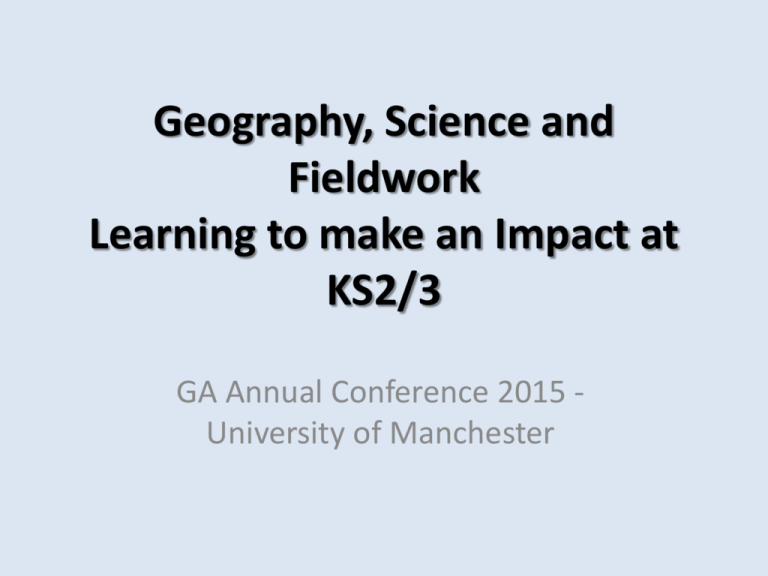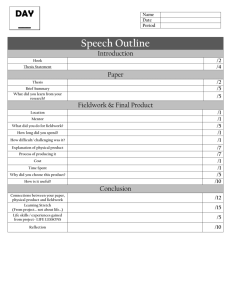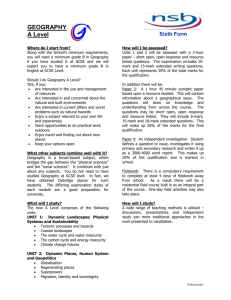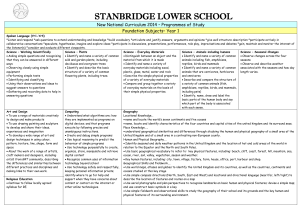Presentation - Geographical Association
advertisement

Geography, Science and Fieldwork Learning to make an Impact at KS2/3 GA Annual Conference 2015 University of Manchester Fieldwork is crucial In geography, learning in the ‘real world’ expresses a commitment to exploration and enquiry, and geography’s concern to discover and to be curious about the world. In the sciences it is that sub-set of practical science that is particularly valuable for introducing students to investigating the complexity and messiness of the real world Geographical fieldwork can be used ‘to inspire in pupils a curiosity and fascination about the world and its people that will remain with them for the rest of their lives’ (DfE, 2013) It is in the nature of laboratory and classroom experiments to separate objects from their environments … But in the ‘natural’ sciences it is only by putting objects and laws in particular contexts that we can see how they work in terms of empirical effects” (p 88). (Hawley, D. 2012) The importance of Place • Place is a way of seeing, knowing and understanding the world • Attachments and connections between people and places • Worlds of meaning and experience • Resistance, reaction exclusions • Place as we choose to think about it and protect it Geographical (and scientific) vocabulary is best learnt through first hand experience (Ward 1998) Place is space given meaning (Tuan 1974) Not One Geography • Understanding of place is affected by who we are; Sex and gender Growing evidence shows that current Age approaches to encouraging sustainable living do not result in long-term, largeEthnicity scale, social change. This is because Sexuality they do not address the deep seated Life cycle stage social, cultural and psychological We become ‘rooted’ to places and form deep attachments that promote feelings of stewardship and concern. (Tuan 1974) structures that hold many unsustainable patterns of behaviour in place. (WWF 2012) Dialogic sharing and evaluation of an environment supports creativity. (Lambert, & Owens 2012) Curriculum making with the academic disciplines as a resource Students’ geographical and scientific lives Geography and sciences as school subjects Geography and science teachers A Fieldwork Continuum GEOGRAPHY The Scientific Tradition Systematic sampling and data collection, controlled structures. Serendipity and Exploration Unsystematic sampling and data collection, flexible and changing structures. Is there a ’best time’ for Fieldwork? To initiative interest and formulate questions To test hypotheses and questions MID To review, apply or consider next steps END EARLY Enquiry REVISIT To test over time, evaluate changes and consolidate learning. Set location(s) Traditional scientific approach, rigid and precise data collection. Quantitative Precise data collection but in random settings. Good for comparing same data, different location. Different & varied perspectives to an identified location A C B D Serendipitous and explorative approach. Personal, empathic and emotive. Random location(s) Fieldwork: what, where and how? Qualitative A Critique of Quantitative Research How often do we take students to interesting places, perhaps areas far removed from their normal range of experience, and then get them to spend most of their time looking at a clip board or measuring instrument? (Taylor 2004) A Critique of Qualitative Research 1. Qualitative research is too subjective 2. Difficult to replicate 3. Problems of generalization 4. Lack of transparency Fieldwork in Science • Easy access to a pond or natural water habitat – e.g. to study adaptations, distribution of organisms, population dynamics, biodiversity, pollution indicators • Easy access to trees or hedges – e.g. to study invertebrate distribution, biodiversity or adaptation • Easy access to grassland (not just the school playing field) – e.g. to study the ecology and the factors that influence the distribution of organisms • Local access to an outside resource to demonstrate the different properties of rocks; the effects of processes (e.g. erosion) on rocks; and to monitor air quality. School grounds or further afield • Easy access to an open space for a variety of activities – e.g. modelling the solar system; measuring speed; launching rockets; measuring noise pollution; estimating the speed of sound; measuring the irradiance from the sky; carrying out solar furnace investigations etc. • Easy access to a real functioning renewable energy source that can be used in teaching – e.g. photovoltaic or wind Synergy and potential for geography and science fieldwork Practical fieldwork activity 1. What is the potential for synergy (and collaboration) between science and geography? 1. Discuss the different possible learning outcomes through science and geography 2. Planning your fieldwork sessions – routes, equipment, techniques etc. 3. Reflect and share – new questions? You have 30 minutes for fieldwork, reflection and sharing Contact details • Marianne Cutler, ASE mariannecutler@ase.org.uk • John Lyon, GA • JLyon@geography.org.uk • Paula Owens, GA • POwens@geography.org.uk References and further reading. • • • • • • • • • • • • • • • • • • Fuller, D. Askins, K. Mowl, M. Jeffries, J. & Lambert, D. (2008) Mywalks: Fieldwork and living geographies Teaching Geography Summer 2008 Sheffield: Geographical Association Hawley, D. (2012) The ‘real deal’ of earth science: why, where and how to include fieldwork in teaching, School Science Review, 94(347), 87-100. Kaplan, R. and Kaplan, S. (2011), Well-being, Reasonableness, and the Natural Environment. Applied Psychology: Health and Well-Being, 3: 304–321. King, F., Young, M., Drivere-Richmond, K. & Schrader, P (2001). Defining Distance Learning and Distance Education. AACE Journal 9 (1): pp. Lambert, D. And Owens, P. (2012) in Jones, R. & Wyse, D. (Eds) Creativity in the Primary Curriculum, Abingdon: David Fulton. Louv, R. (2008) Last Child in the Woods Chapel Hill: Algonquin Pub Mezirow, J. (1995). "Transformation Theory of Adult Learning." In: In Defense of the Lifeworld, edited by M.R. Welton, pp. 39– 70. New York: SUNY Press. Mezirow, J. (1997). Transformative Learning: Theory to Practice. New Directions for Adult and Continuing Education, 74, 5–12. Mezirow, J. (2000). Learning as Transformation: Critical Perspectives on a Theory in Progress. San Francisco: Jossey Bass. Owens (2008) MYWALKS: Walk on the Child Side Primary Geography Autumn 2008 Payne, P. & Wattchow, B. Phenomenological Deconstruction, Slow Pedagogy, and the Corporeal Turn in Wild Environmental/Outdoor Education. Canadian Journal of Environmental Education, 14, 2009pp.15 – 32 Pretty J. Angus C. Bain M. Barton J. Gladwell V. Hine R. Pilgrim S. Sandercock, S. and Sellens, M. 2009. Nature, Childhood, Health and Life Pathways, Interdisciplinary Centre for Environment and Society Occasional Paper 2009-02.University of Essex, UK. Taylor, E. W. (2001) Transformative learning theory: a neurobiological perspective of the role of emotions and unconscious ways of knowing Int. J. Of Lifelong Education, VOL. 20, NO. 3 (May–June 2001), 218–236 Torosyan, Roben. (2007). Teaching for Transformation: Integrative Learning, Consciousness Development and Critical Reflection. Unpublished manuscript. http://www.faculty.fairfield.edu/rtorosyan/ Tuan, Yi-Fu (1974) Topophilia: A Study of Environmental Perception,Attitudes and Values. Prentice Hall. Englewood cliffs, New Jersey. Ward, H. (1998) ‘Geographical Vocabulary.’ In Scoffham, S. (ed.), Primary Sources: Research Findings in Primary Geography. Sheffield: The Geographical Association. Pp. 20–21. WWF (2012) http://www.naturalchange.org.uk/about-the-project/ accessed 23.02.2012




